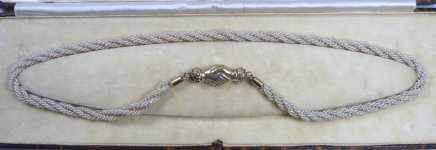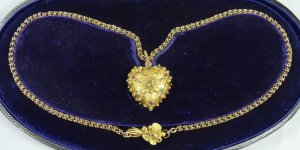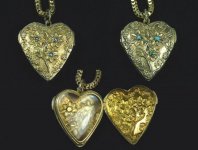Third in a series by Antique Jewelry Collector Paul Royse. See the first one here.
Antique Pearl Jewelry that YOU could own - 1800 to 1850
By Paul Royse
By the end of the 1700's a great nation had formed through the American War of Independence (1775?1783), and another great nation was transformed as a result of the French Revolution (1789-1799).
Transformations also occurred at the personal level. New ideas of freedom and liberty were in the air, and new forms of literature appeared. Jane Austen wrote the first novels from a woman's perspective, and Wordsworth and Coleridge created a new style of poetry that emphasized emotions and personal expression.
This was the beginning of the Romantic Era, lasting approximately 1800 to 1850. The name refers to a new interest in the romance (or intensity) of personal experience.
The Romantic Era was the period when gifting jewels as love tokens really became entrenched. Jewelers have never looked back.
Early 1800's jewelry was still entirely hand fabricated, with exquisite attention to detail. It usually carries a message or meaning, obvious to people of the time, but not always understood today.
The seed pearls in the necklace below are just 1mm, drilled by hand. Three strands are woven into a string, with three strings then woven together as the necklace rope. The gold clasp depicts two clasped hands, known as a "fede", from the Italian "Mani in Fede", meaning "hands (clasped) in trust".
The clasped hands represent the trust of friendship and the trusting lovers' grasp. It is also the handshake that seals a contract, certain in this case to be a marriage contract.
In the language of gems, pearls stand for purity and sanctity, with a similar meaning to the bride's white wedding gown. This necklace was a betrothal gift, to be worn by the bride on her wedding day, and full of meaning to the giver and the recipient.

The next piece doesn't feature pearls, however it's worthwhile to see an example of cannetille work, popular in the 1820's to 1830's, and often found set with pearls. The word "cannetille" means lace-like, and cannetille jewelry is made with very fine chased work and gold or silver threads.
This is a cannetille locket set with stones in the order: Ruby, Emerald, Garnet, Aquamarine, Ruby, and Diamond, thus spelling REGARD. Once again this is a love token with layers of meaning, for regard means "to see", and also "love", so the meaning is something like "I saw you and fell in love".

Another heart shaped love token locket is shown below, in 18k gold, hallmarked for Birmingham 1820, maker TN (probably the vinaigrette maker Thomas Newbold).
Again we see the superb craftsmanship of the period, with a classic combination of repousee work and chasing. It's also a great example of how jewelry of the time was poignant with meaning.
The locket is heart shaped, symbolizing love (of course). Bordering this on both sides are grape vines bearing fruit. One side has flowers set with pearls, the other flowers set with turquoise.
The grape vine signifies both victory and eternity. The pearl set flowers represent daisies, symbolizing purity, innocence, and loyal love. The turquoise flower is the forget-me-not, with a meaning of lasting true love. The snake chain is also part of the symbolism, as the snake is another symbol of eternity.

This will be another betrothal piece, given by a man to his fianc? at the time of their engagement, to be worn at the wedding, and at important social occasions both before and after.
In the act of giving the man professed his loyal love to his betrothed. She would show the pearl/daisy side prior to the wedding, symbolizing her purity (chastity) before the wedding and her eternal loyalty to her prospective husband. After the wedding the turquoise forget-me-not would be shown to symbolize the couple's eternal love. So the total message could be paraphrased as "Lovers Forever".
A gold locket like this was only affordable to the upper strata of English society, and at the time this was a fairly exclusive group of around 40,000 families (about 3% of the population) earning more than ₤200 per annum.
These lockets were even fit for a queen, as we see in the following portrait by Herbert Smith of the young Queen Victoria in the year of her wedding (1840), proudly displaying her gold locket necklace.
![VictoriasLocket[1].jpg VictoriasLocket[1].jpg](https://www.pearl-guide.com/data/attachments/22/22064-92ed942c808420f6b383fd42ab4b2add.jpg)
The memorial rings, brooches and pocket watches ringed with pearls seen in the 1700's still remained in fashion through the first half of the 1800's. However a particular variation on the pearl ringed pocket watch is worthy of mention.
This is the "Chinese Market" pocket watch, made by European firms for export to China, where they became status symbols amongst the nobility. Features that appealed to the Chinese included enameled cases and intricate visible movements.

For more information on Chinese Market watches, and the story behind this particular watch, see the article on the Pearl-Guide Forum here.
Collectors Tips
Pieces from the early 1800's do still turn up with their origins unrecognized. Once again condition is everything, and anything more than minor repairs are extremely difficult and/or costly.
If you're lucky enough to find a piece in good condition, a little research can go a long way. Love tokens are far more appealing (and valuable) to buyers than memorial pieces. The cannetille locket above has a lock of hair in it, however this is a keepsake from the giver, not a memorial of one deceased. Past owners had lost the history and didn't recognize the message in the gemstones, or the intricacy of the gold work, and it was sold as a Victorian mourning item. The second locket was also a bargain find, as previous owners had missed the hallmarks, and again this was sold as Victorian.
Similarly, Chinese Market watches can go unrecognized. They're very similar to the French and Swiss watches made for European markets around the same time. However the Chinese Market version is worth a great deal more, largely due to demand from Chinese collectors.
If you do want to research your item of pearl jewelry, join the Pearl Guide Forum, it can be a very enriching experience!
Jewelry photographs courtesy of the Royse family collection
Painting of Queen Victoria ca 1840 by Herbert Luther Smith courtesy of Wikimedia Commons
See the next installment here.
Antique Pearl Jewelry that YOU could own - 1800 to 1850
By Paul Royse
By the end of the 1700's a great nation had formed through the American War of Independence (1775?1783), and another great nation was transformed as a result of the French Revolution (1789-1799).
Transformations also occurred at the personal level. New ideas of freedom and liberty were in the air, and new forms of literature appeared. Jane Austen wrote the first novels from a woman's perspective, and Wordsworth and Coleridge created a new style of poetry that emphasized emotions and personal expression.
This was the beginning of the Romantic Era, lasting approximately 1800 to 1850. The name refers to a new interest in the romance (or intensity) of personal experience.
The Romantic Era was the period when gifting jewels as love tokens really became entrenched. Jewelers have never looked back.
Early 1800's jewelry was still entirely hand fabricated, with exquisite attention to detail. It usually carries a message or meaning, obvious to people of the time, but not always understood today.
The seed pearls in the necklace below are just 1mm, drilled by hand. Three strands are woven into a string, with three strings then woven together as the necklace rope. The gold clasp depicts two clasped hands, known as a "fede", from the Italian "Mani in Fede", meaning "hands (clasped) in trust".
The clasped hands represent the trust of friendship and the trusting lovers' grasp. It is also the handshake that seals a contract, certain in this case to be a marriage contract.
In the language of gems, pearls stand for purity and sanctity, with a similar meaning to the bride's white wedding gown. This necklace was a betrothal gift, to be worn by the bride on her wedding day, and full of meaning to the giver and the recipient.

The next piece doesn't feature pearls, however it's worthwhile to see an example of cannetille work, popular in the 1820's to 1830's, and often found set with pearls. The word "cannetille" means lace-like, and cannetille jewelry is made with very fine chased work and gold or silver threads.
This is a cannetille locket set with stones in the order: Ruby, Emerald, Garnet, Aquamarine, Ruby, and Diamond, thus spelling REGARD. Once again this is a love token with layers of meaning, for regard means "to see", and also "love", so the meaning is something like "I saw you and fell in love".

Another heart shaped love token locket is shown below, in 18k gold, hallmarked for Birmingham 1820, maker TN (probably the vinaigrette maker Thomas Newbold).
Again we see the superb craftsmanship of the period, with a classic combination of repousee work and chasing. It's also a great example of how jewelry of the time was poignant with meaning.
The locket is heart shaped, symbolizing love (of course). Bordering this on both sides are grape vines bearing fruit. One side has flowers set with pearls, the other flowers set with turquoise.
The grape vine signifies both victory and eternity. The pearl set flowers represent daisies, symbolizing purity, innocence, and loyal love. The turquoise flower is the forget-me-not, with a meaning of lasting true love. The snake chain is also part of the symbolism, as the snake is another symbol of eternity.

This will be another betrothal piece, given by a man to his fianc? at the time of their engagement, to be worn at the wedding, and at important social occasions both before and after.
In the act of giving the man professed his loyal love to his betrothed. She would show the pearl/daisy side prior to the wedding, symbolizing her purity (chastity) before the wedding and her eternal loyalty to her prospective husband. After the wedding the turquoise forget-me-not would be shown to symbolize the couple's eternal love. So the total message could be paraphrased as "Lovers Forever".
A gold locket like this was only affordable to the upper strata of English society, and at the time this was a fairly exclusive group of around 40,000 families (about 3% of the population) earning more than ₤200 per annum.
These lockets were even fit for a queen, as we see in the following portrait by Herbert Smith of the young Queen Victoria in the year of her wedding (1840), proudly displaying her gold locket necklace.
![VictoriasLocket[1].jpg VictoriasLocket[1].jpg](https://www.pearl-guide.com/data/attachments/22/22064-92ed942c808420f6b383fd42ab4b2add.jpg)
The memorial rings, brooches and pocket watches ringed with pearls seen in the 1700's still remained in fashion through the first half of the 1800's. However a particular variation on the pearl ringed pocket watch is worthy of mention.
This is the "Chinese Market" pocket watch, made by European firms for export to China, where they became status symbols amongst the nobility. Features that appealed to the Chinese included enameled cases and intricate visible movements.

For more information on Chinese Market watches, and the story behind this particular watch, see the article on the Pearl-Guide Forum here.
Collectors Tips
Pieces from the early 1800's do still turn up with their origins unrecognized. Once again condition is everything, and anything more than minor repairs are extremely difficult and/or costly.
If you're lucky enough to find a piece in good condition, a little research can go a long way. Love tokens are far more appealing (and valuable) to buyers than memorial pieces. The cannetille locket above has a lock of hair in it, however this is a keepsake from the giver, not a memorial of one deceased. Past owners had lost the history and didn't recognize the message in the gemstones, or the intricacy of the gold work, and it was sold as a Victorian mourning item. The second locket was also a bargain find, as previous owners had missed the hallmarks, and again this was sold as Victorian.
Similarly, Chinese Market watches can go unrecognized. They're very similar to the French and Swiss watches made for European markets around the same time. However the Chinese Market version is worth a great deal more, largely due to demand from Chinese collectors.
If you do want to research your item of pearl jewelry, join the Pearl Guide Forum, it can be a very enriching experience!
Jewelry photographs courtesy of the Royse family collection
Painting of Queen Victoria ca 1840 by Herbert Luther Smith courtesy of Wikimedia Commons
See the next installment here.

